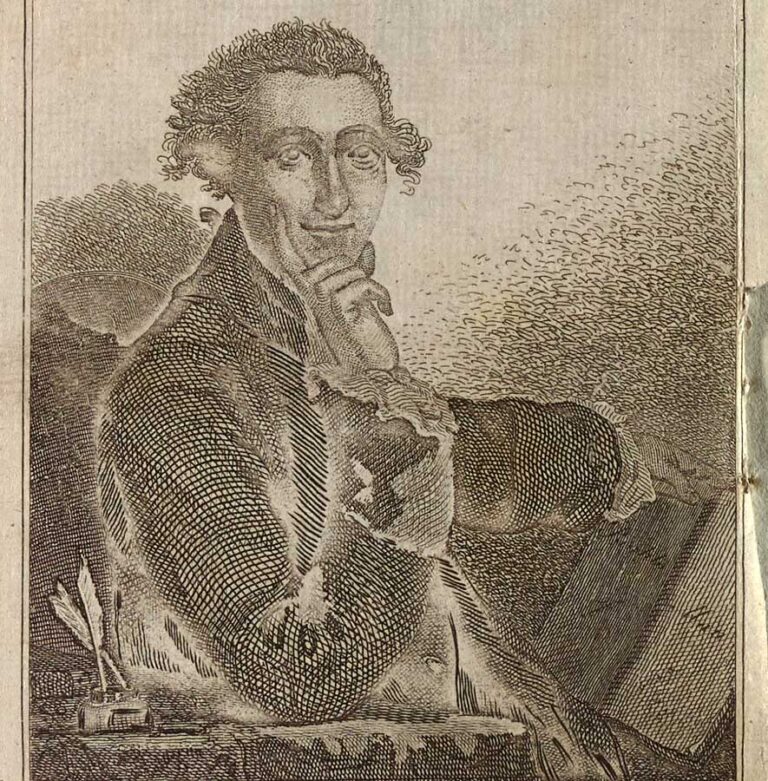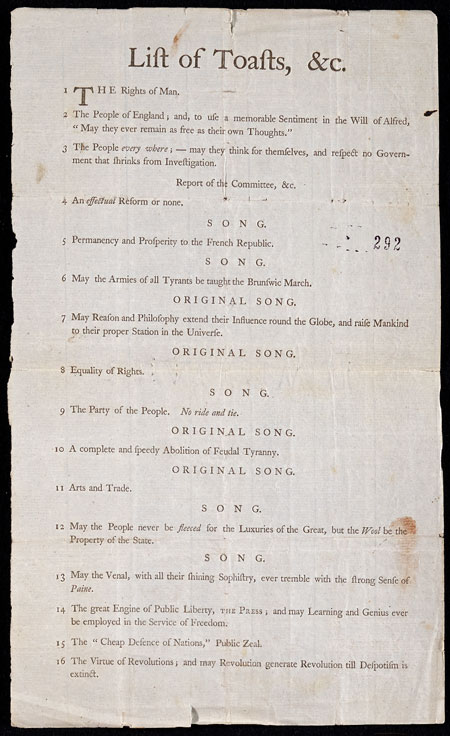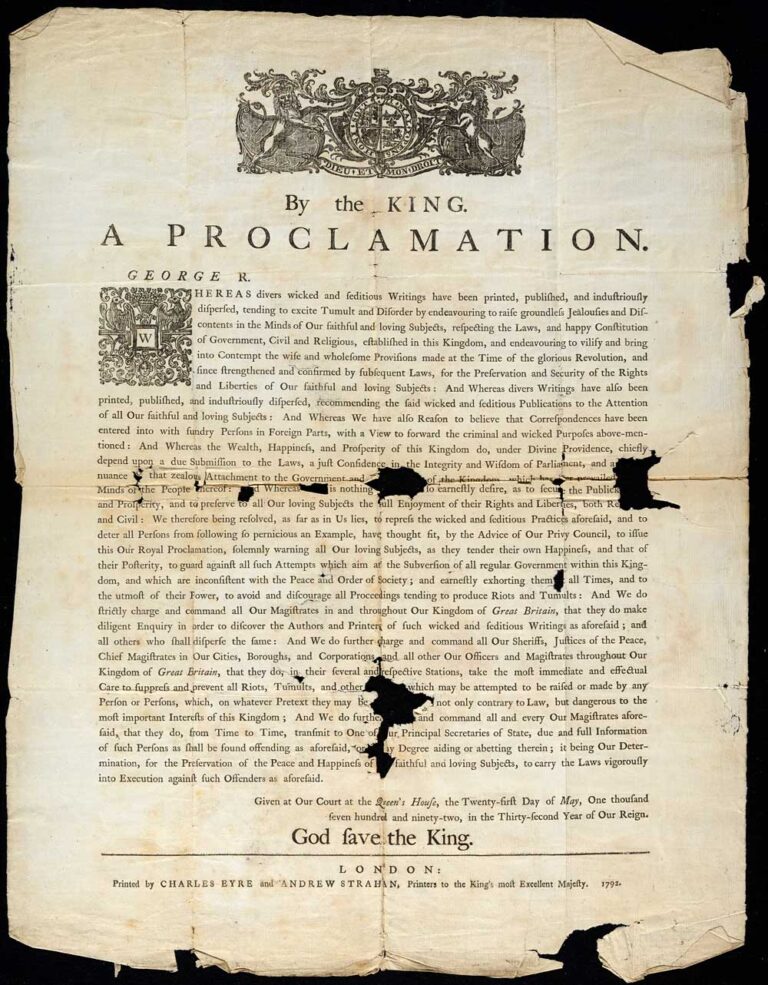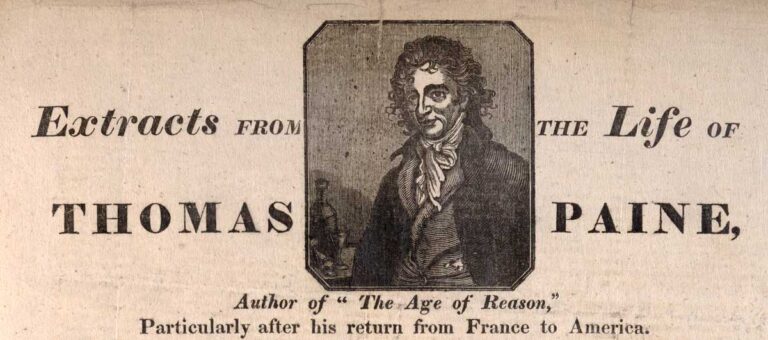In December 1792, detachments of the 2nd Dragoon Guards across the Southwest of England staged spectacles of hate. A dummy was paraded through the towns on an ‘ass’ led by a hangman, the crowd of soldiers and residents encouraged to subject it to ‘every possible mark of indignity’.
At the customary place of execution, it was burned amidst repeated exclamations of ‘“God Save the King”, and constant cheering and huzzahring’. The dummy was an effigy, of the radical writer Thomas Paine (see footnote 1).

Paine was no stranger to controversy – he had been a vocal supporter of the American Independence. By 1790, he had moved on to become the most prominent English advocate of the French Revolution (see footnote 2).
A revolutionary riposte
The French Revolution began in 1789 as Louis XVI, facing a gigantic economic crisis, called an Estates General, an advisory assembly, to discuss solutions. The Estates General was made up of three separate Estates: The First comprised the aristocracy, the Second the clergy, and the Third represented all others, although its members were largely drawn from the professional middle classes (see footnote 3). The Third Estate unilaterally created a National Assembly, a kind of parliament, and began demanding a constitutional monarchy. Monarchist counterrevolutionaries, with the support of European powers including Britain, resisted change, and plotted. In the Assembly and its successors, republicans gained ascendancy, and the French Republic was proclaimed in August 1792. The Republic declared the equality of rights and liberty, but it was threatened on all sides. On 17 January 1793 the former King, now Citizen Louis Capet, was executed.
The American Revolution had plenty of supporters in Britain’s elite, including Edmund Burke MP, now considered the founder of modern conservatism. But the French were a different, more radical quantity. Burke used his 1790 pamphlet, Reflections on the Revolution in France, to predict the Revolution would collapse into blood anarchy. He upheld Britain’s Parliamentary constitution, which excluded most of its workers from voting, as a bulwark against such tyranny that must be cherished.

Rights of Man, published in two parts in 1792, was Paine’s riposte to Burke. Britain’s constitution was out-of-date, ‘eclipsed by the enlarged orb of reason, and the luminous revolutions of America and France’. In the second part he laid out practical steps to renew it, including universal suffrage and the abolition of the monarchy. Such ideas were dangerous. The government bought copies of Rights of Man, prosecutors underlining offending passages (see footnote 4).
Paine was not the only radical pamphleteer, but he was the most infamous. The Home Office’s correspondence was awash with alarmed reports of its distribution – it was sold cheaply, or given away gratis, sometimes even to troops. It was being translated into Welsh, as an ‘infestation’ of Methodist preachers extolled its doctrines. A bookseller holding a lucrative position as a tax-collector had sold 1,000 copies (see footnote 5).
What’s more, this dissemination of literature seemed to be translating into wider radicalism. In December a list of toasts proposed at a dinner of the Reforming Society in Borough (Southwark, probably the Friends of the People) was sent to the Home Secretary. They included not just the ‘Rights of Man’, and ‘the People’, but also for the ‘Abolition of Feudal Tyranny’, and the ‘Virtues of Revolutions’.
Two days later it was reported that over 40,000 muskets had been sold in London. It was claimed that another reform group, the Society for Constitutional Information, had raised a subscription for a substantial portion of these, and that they might be storing them to arm a French invasion force. There was little hard evidence of such a scheme, but the atmosphere was febrile (see footnote 6).
Sedition: cousin of treason
To try and quell the radical press, the government issued a Royal Proclamation on 22 May 1792 against ‘wicked and seditious Writings … endeavouring to vilify and bring into Contempt the wise and wholesome’ constitution.
Magistrates were charged with seeking out the authors and printers of such material, and reporting to government on radical activities. All subjects were instructed to, ‘guard against all such Attempts, which aim as the Subversion of all regular Government within this Kingdom’. Paine was not named, but he was implicitly the target (see footnote 7).

It was not long before Paine was named by the government, his name on an indictment for seditious libel. Sedition was the close, junior cousin of treason, characterised by the jurist Francis Holt as an ‘endeavour to despoil’ the state of the ‘affection of its people’, but not going as far as attempting to overthrow it. The Attorney General, prosecuting, explained to the jury that Paine had written Rights of Man intent on making ‘the lower orders of society disaffected to Government’.
The trial, at the Court of the Kings Bench, began on 18 December 1792. Paine was defended by Thomas Erskine, perhaps the greatest lawyer of his generation. Erskine used his defence speech to argue for freedom of press and expression. He described the proceedings as little more than a show-trial. Proving his point, the jury informed the court there was no need for the prosecution to make a counterargument – they were already convinced of Paine’s guilt. The government and loyalist vilification of him was working (see footnote 8).
Paine was convicted in absentia – he was in France at the time, where he had been elected a member of the revolutionary National Convention. But, Paine’s conviction allowed the government to say that his ideas, and those of radicalism, were a threat to the stability of the constitution, and therefore the Crown. When the reformers of the London Corresponding Society were tried for High Treason in 1794, it is no coincidence that large chunks of Rights of Man, which they had promoted, were read out as prosecution evidence.
The treason trials failed, not least because of Thomas Erskine, who again led the defence. But Paine was firmly cemented as a loyalist folk-devil, he – and his ideas – seditious, dangerous, even treasonous, soaked in the blood of the French Revolution (see footnote 9).

Paine never returned to Britain, returning to America, where he held citizenship, in 1802. He continued to write prolifically on American, French and British politics, but his health failed, and he died in 1809. Such was his legacy and influence, though, his writings remained central to later radicals. His supposed villainy, slovenly habits and excessive drinking continued to be attacked by loyalists.
Paine was never charged with treason in Britain. Indeed, the closest he came to a traitor’s death was at the hands of the Terror’s Committee of Public Safety, who imprisoned him in December 1793. But to many British people, he was a traitor nonetheless. Treason is emotional as much as it is legal. Paine’s conviction for seditious libel laid the ground for the trials of peaceful radicals and set the stage for decades in which parliamentary reformers were ever on the precipice of accusations of treason (see footnote 10).
Treason: People, Power & Plot is a free exhibition from The National Archives on the history of treason since 1352. Open until 6 April 2023, the exhibition brings iconic and unknown archival documents to life from nearly 700 years of treasonous history, including those of the American Revolution and the activities of Parliamentary Reformers in Britain.
The exhibition’s curators have written an accompanying book, A History of Treason (John Blake Publishing), which examines the treasons featured in the exhibition and more, copiously illustrated with images from the unrivalled collections of The National Archives. It is available to buy from The National Archives bookshop and all other good bookstores.
Footnotes
- Catalogue reference: HO 42/23/210.
- Mark Philp, ‘Paine, Thomas (1737–1809), author and revolutionary’, Oxford Dictionary of National Biography, 23 Sep. 2004. Available at: https://www.oxforddnb.com/view/10.1093/ref:odnb/9780198614128.001.0001/odnb-9780198614128-e-21133 (accessed 03/02/2023).
- Monarchists hoped that the more radical Third Estate would be outnumbered by the other two, as the Estates sat separately then deliberated each other’s decisions. However, members of the Third Estate, with support with some radical aristocrats and clergymen, formed the Assembly, demanding a unicameral chamber (ie a single body that could vote and make laws on its own). Louis XVI attempted to disrupt their proceedings but failed. After the storming of the infamous Bastille prison on 14 July 1789 made clear the potential for revolt in Paris and elsewhere, Louis was forced to agree to a constitutional monarchy. The Bastille was eventually torn down. The Marquis de Lafayette, a prominent radical aristocrat who had also been a hero of the American Revolution, entrusted Thomas Paine to deliver its key to Washington, as a symbol of friendship between France and America.
- Catalogue reference: TS 24/3, Treasury Solicitor’s copy of Thomas Paine’s The Rights of Man, Part 1, J Parson, London, 1792. Seditious passages are underlined throughout the text, and a manuscript note on the cover states it was purchased in Colchester, Essex on 1 December 1792.
- Catalogue references: HO 42/21/119, HO 42/22/30, HO 42/22/221, HO 42/23/170. The author would like to thank all the volunteers on the HO 42: Home Office Domestic Correspondence George III cataloguing project, past and present, without whose work such letters would take much longer to find.
- Catalogue references: HO 42/23/128, HO 42/23/148. The Society for Constitutional Information was established in 1780 by Major John Cartwright, one of the ‘fathers’ of the reform movement. Its membership and leadership were predominantly middle class, but it enthusiastically promoted Paine’s work and the cause of reform.
- Catalogue reference: TS 24/1/1. A copy of the proclamation was printed in the London Gazette (issue 13419, 26 May 1792, pp. 341-342. Copies were also circulated to Lord Lieutenants and magistrates. In response the Home Office received many loyal addresses from ‘respectable’ inhabitants approving of the proclamation (see HO 42/20-22 for examples).
- The Trial of Thomas Paine, for a Libel, contained in the second part of Rights of Man, before Lord Kenyon, and a Special Jury, at Guildhall, December 18th, C & G Kearsley, London, 1792.
- Paine remained associated with revolutionary and Jacobin doctrine despite falling foul of it himself. He was imprisoned in December 1793, as part of the ‘Reign of Terror’. He barely escaped execution, but was eventually freed, not least because of pressure from the Americans.
- Paine was freed from prison in France after the fall of Robespierre and the end of the Terror, in no small part thanks to the United States Ambassador to France (and future President), James Monroe, who argued that Paine was an American citizen. He was released on 4 November 1794. In London the next day, Guy Fawkes Night, Thomas Hardy, the secretary of the London Corresponding Society who had been so inspired by Rights of Man, was freed after he was acquitted of High Treason.
I grew up in Thetford in Norfolk, the birthplace of Thomas Paine, we were taught about him at School and I read The Rights of Man at the time not really understanding it, but now its an interesting read, he was one of those early radicals who had a solution that wasn`t listened to by the government very similar to today where shall we say the common man can see a solution but because he isn`t of the Establishment he is a nobody and not to be listened to.
If memory serves on Thomas Paine`s statue are the lines English by Birth, American by Adoption, French by Politics , he falls into the same group as John Paul Jones the Scot from Kirkbean in Kirkcudbrightshire Scotland, Father of the US Navy , A Traitor or a Hero ?
Thomas Paine and John Paul Jones, visionary figures challenging the status quo, embody the ongoing struggle of ideas and legacies.